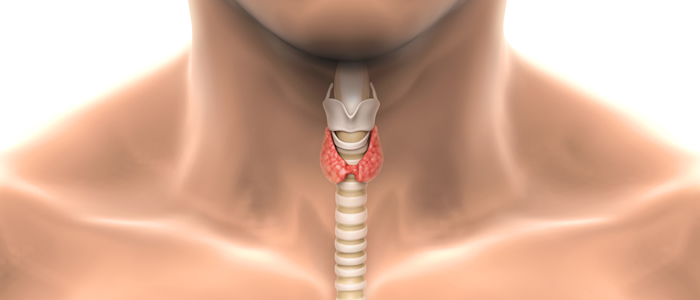
Thyroid Cancer
The majority of thyroid nodules are benign; however, roughly 5 percent of thyroid nodules are cancerous. Over 60,000 new cases of thyroid cancer are diagnosed yearly in the United States. The two different groups of thyroid cancer are well-differentiated and poorly-differentiated. Well-differentiated cancers include the most common cancers, papillary thyroid carcinoma and follicular carcinoma. They are generally highly treatable. Poorly-differentiated thyroid cancers include medullary thyroid cancer and anaplastic cancer. They are considered more aggressive and have a poorer prognosis. Lymphoma can also affect the thyroid gland. Here is a detailed overview of the thyroid cancers that may negatively affect the throat.
Papillary Thyroid Carcinoma
Many studies suggest that papillary thyroid carcinoma is one of the most common types of thyroid cancer. The disease accounts for roughly 85 percent of well-differentiated thyroid carcinomas. These cancers occur much more commonly in women than in men, and typically affect people between the ages of 25 and 55. Other risk factors for papillary thyroid cancer include a personal history of radiation exposure and a family history of thyroid cancer. It is typically detected on physical examination as a mass that is felt within the thyroid gland. Approximately 15 to 30 percent of patients with papillary thyroid carcinoma may also experience difficulty swallowing, hoarseness, or shortness of breath.
The treatment of papillary thyroid carcinoma usually involves surgery to remove the entire thyroid gland. In rare situations, for a small, 1cm thyroid cancer, it may be appropriate to remove just half of the thyroid gland. If this decision is made, it is important that both the patient and the surgeon understand the risk of recurrence, which occurs in 5-10% of these cases. If there are visible lymph nodes in the neck, a surgeon may also perform a neck dissection in addition to removing the entire thyroid gland. Post-operative treatment with oral thyroid hormone replacement medication is necessary when the entire thyroid is removed. Depending on the findings at the time of surgery, post-operative treatment with radioactive iodine may also be indicated.
Follicular Thyroid Carcinoma
Follicular thyroid cancer is the second most common type of thyroid cancer, occurring in about 15% of thyroid cancer cases. Also more common in women than men, it tends to occur in slightly older patients than papillary thyroid cancers, with a peak age of onset between 40 and 60 years old. It is rarely related to prior radiation exposure. The overall cure rate is high, but decreases with increasing age of the patient and increasing size of the cancer. It rarely spreads to nearby lymph nodes, but rather can spread to the lungs and bones.
The treatment of follicular thyroid carcinoma is similar to that of papillary thyroid cancer. A total thyroidectomy, or removing the entire thyroid gland, is typically indicated. Oral thyroid replacement medication is necessary after surgery, and radioactive iodine can sometimes be helpful as part of the treatment plan.
Medullary Thyroid Carcinoma
Medullary thyroid cancer comprises approximately 3-4% of all thyroid cancers. They typically present as a neck mass, and often have spread to nearby lymph nodes in the neck at the time of discovery. About 25% of medullary thyroid cancers are familial, and can be associated with other endocrine tumors. Any patient with the familial version of medullary thyroid cancer should be screened for these other tumors. The treatment for medullary thyroid cancer typically involves removal of the entire thyroid gland, and oftentimes it is necessary to remove the lymph nodes in the neck as well. Radioactive iodine treatment has no role in the treatment of medullary thyroid cancer.
Anaplastic Carcinoma
Anaplastic carcinoma is an aggressive subtype of thyroid cancer that represents less than 2 percent of all thyroid cancers. When anaplastic carcinoma is present, it can be very aggressive, and tends to involve structures around the thyroid gland, including the airway and the esophagus. Sometimes, a tracheostomy surgery is necessary in order to secure the airway. Anaplastic carcinoma is more common in the elderly, and it can present with a rapidly growing neck mass, difficulty swallowing, hoarseness, and even difficulty breathing.
In order to secure the airway, a tracheostomy is typically performed. When a tumor is discovered in its early stages, the doctor may recommend surgery or even external beam radiotherapy to slow its growth.
Lymphoma
Primary lymphoma of the thyroid gland usually arises from the lymph nodes, but the condition can also arise from a non-nodal site like the thyroid gland. This disease has been shown to account for less than 5 percent of all thyroid cancers.
When primary lymphoma of the thyroid is present with a fast-growing thyroid mass, the following symptoms may persist:
- Difficulty swallowing
- Hoarseness in the throat
- Cough or shortness of breath
After a biopsy as well as PET and CT scans are performed, the doctor will evaluate the extent at which the disease has spread. Primary lymphoma of the thyroid is a curable disease when treated early. It is similar to treatment of lymphoma in other areas of the body, and typically involves chemotherapy and/or radiation.
Overall, thyroid cancers make up a small percentage of thyroid nodules. However, if you notice a mass at the lower portion of the front of your neck, or if you have hoarseness, difficulty swallowing or difficulty breathing, it is recommended you are evaluated by a physician. If there is concern for a thyroid mass, evaluation by an ear, nose, and throat specialist may be indicated.

